Pacifica now offers electrifying performance
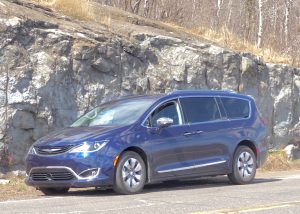
New Pacifica Hybrid Limited combines 3.6-liter V6 with electric hybrid power for smooth operation and high fuel economy.
Road-testing different vehicles every week can be similar to playing a real-life scene in “The Three Bears.” Open the door of a big pickup or large SUV, and you might say, “This is too high” as you high-jump aboard. Open the door of a normal size car the next week and you might say, “This is too low,” as you duck your head and drop down into the seat. And catch one of the dozens of new compact crossover SUVs, and be ready to adjust to either climbing up a lot or a little.
Then the 2018 Chrysler Pacifica Hybrid Limited shows up. You open the door, mentally prepared to climb up, then realizing you don’t need to, so you anticipate dropping down, but no. You simply step in and you are aboard.
“This,” says everyone from Papa Bear to Mama Bear to Baby Bear, “is just right.”
It wouldn’t seem so startling, except for all the variations that require ducking heads or hand-grip helpers to climb up or down. Indeed, we have almost caused minivans to skip out of our consciousness, and we shouldn’t.
My wife, Joan, and I took some good friends out for $1 Taco Night at Gronk’s in Superior, Wis., and we heard a number of comments, mostly of surprise. “There’s a lot of room in here.” Or, “Look at the cordless headphones.” Or, “There’s a lot of room in the third row, too.”
And that was before they had noticed what Joan and I caught almost immediately: The Pacifica Hybrid
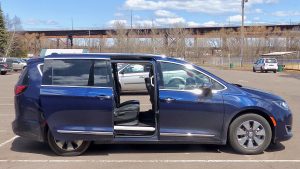
Side doors that open by key fob open the Pacifica to comfortable seating for five behind the front buckets.
Limited rides with amazing smoothness, and corners and even swerves without leaning, without losing its poise, and without anything approaching concern. It goes where you point it, and wherever the front end goes, the rest follows willingly along.
Chrysler, under Fiat fiefdom, made the switch a year ago, ending the long and highly successful run of the Dodge Caravan, and sister ship Plymouth-then-Chrysler Voyager, replacing them with an entirely new vehicle in the Pacifica. It was designed as a people hauler, as are all minivans, but this idea was to make it a stylish, contemporary family hauler that might someday elevate owning a minivan back to its once-exalted status.
You know the story. Station wagons gave way to minivans, and one day somebody woke up and decided minivans were “mom-mobiles,” good for hauling kids to soccer games and practices — or hockey, if you’re a Minnesotan — but outmoded for going to real events where a luxury sedan or SUV was the order of the day.
Minivans have soldiered on, and after the Pacifica made its worthy bid, and Honda followed with a much improved Odyssey, the realization hit those of us who test and compare different vehicles to realize that despite the scorn, minivans are still the most efficient, comfortable and economical way to haul families or, yes, soccer or hockey players, anywhere.
For 2018, there isn’t much change in the Pacifica, except the promised hybrid model is up and running, and it makes the Pacifica Hybrid the most fuel-efficient minivan in the industry.
The timing of my test week was interesting, because a “normal” Pacifica Limited was scheduled, but the week before it came, the scheduled vehicle had to be whisked away and sent elsewhere, and the substitute was the Pacifica Hybrid, also in top-end Limited livery. That meant I would have the unusual opportunity to drive both versions, back to back, for comparison purposes.
Also, this was not “just” a hybrid, although that’s big news on its own. This one is a plug-in hybrid, which has a neat little trap door on the front left flank, with a serious, industrial-strength outlet inside. Open the rear hatch and you will see a couple of small doors on the inner walls. On the lower left, you find a coiled cable with a serious-looking plug.
Now, California and the West Coast, and places on the East Coast are way ahead of Duluth, Minnesota, when it comes to electric car and even hybrid sophistication, but I was surprised and impressed recently when we went for a walk along that part of the Lake Walk that survived the late-winter battering from Lake Superior waves that a storm sent crashing out of its rather spacious basin. We walked for a few blocks, but the wind whistling off the big lake made our walk more of a challenge than we were looking for, so we turned inland and walked over toward 1st Avenue East. As we got there, we noticed three rows of parking with odd signs and devices. They are charging stations.
Electric car and plug-in hybrid charging stations in Duluth, Minnesota? Are you kidding me? Great!
Typical hybrids, you realize, have high-output but diminutive electric motors that can supplement a small engine’s power and even replace it for a few miles of moderate use, then normal driving lets the gas engine recharge the battery pack for further hybrid-electric help. Electric cars, on the other hand, don’t have any gas engine to recharge, and must be plugged in.
Plug-in hybrids are, to me, the best available compromise for everyday people. You don’t have the feeling of latent panic wondering if your electric car is going to run out of stored electricity, and you also don’t have to wonder how much of a charge your normal hybrid has executed. You can do a shorter plug-in at a charge site, and get your electricity fully loaded.
The Pacifica is the first minivan to have such a feature. It comes with a 3.6-liter Pentastar V6 in the normal Limited, which has a healthy 287 horsepower and 262 foot-pounds of torque, driving the front wheels. The battery pack and hybrid paraphernalia weigh a little, and cause the V6 to be tuned much differently, but then it combines to provide a total of 260 horsepower that moves the Pacifica with smooth force.
Despite what the numbers hint, the Hybrid Pacifica combines its two power sources in a manner that feels significanly quicker and faster than the normal one.
The other thing hybrids do along with coordinating and supplementing power from the gas engine is they can allow the vehicle to operate on electric power only. You don’t get much distance out of electric-only driving. Maybe 10 miles, before you’ll need to coast and brake and recharge the system internally. But with the plug-in charge filling the eletric capacity, you can go a reported 35 miles on electric power only.
To do that, you’d want to push the start button, and don’t think it failed you. It will be silent, but will notify you that it’s ready. Put the 9-speed transmission in gear and feather the gas, and off you go. You don’t want to stand on the gas, just creep away and you could make it to work and all the way home without exhausting the electric charge.
Stepping on it hard, to accelerate swiftly or to climb a steep hill, will cause the electric motor to hustle to help the gas engine and provide surprisingly strong force. It also will drain the electric juice long before that 35-mile range.
But it is fun to give it a little “gas” for brief moments now and then, just to surprise yourself with how swift the Pacifica Hybrid is. When adequately charged, you get smooth and seamless power that fits the Pacifica so well.
As gasoline rises inexorably up, up and away, you also can appreciate the fuel economy. The Limited non-hybrid showed us mid-20s for fuel economy, which isn’t bad. The hybrid, however, stayed mostly above 30 mpg, and that was without plugging in but trusting the normal hybrid system to do its charging.
The EPA estimates show the Pacifica Limited at 29 city and 28 highway, while the Pacifica Hybrid Limited shows 32 combined city-highway mpg, and a whopping 84 miles per gallon with the fully-charged hybrid system for combined city-highway driving, and plugging in for a 2-hour high-potency charge provides the top numbers.
Both vehicles came loaded with options, including all the safety stuff, a full-length panoramic sunroof, adaptive cruise, lane-departure warning, autostart, Apple CarPlay and Google Android capable, park assist, and both with Chrysler’s creative and imaginative power rear seat flip, hide, fold and disappear, plus power sliding side doors and both with opening side windows(!).
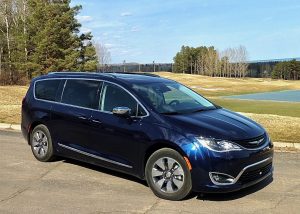
SUVs are all the rage, but top-level minivans like the Pacifica remain the best family-friendly way for feature-filled travel. .
The Hybrid Limited has a base price of $44,995 and an as-tested sticker of $48,580; the non-hybrid Limited starts at $43,695 and as-tested $49,665. Amazing, but the non-hybrid is a thousand more than the hybrid.
The hybrid model was Jazz Blue, and the non-hybrid was Velvet Red, both pearl-coat paint jobs. That made it easier to tell the difference after we had swapped one for the other.
And our friends, who own SUVs, trucks, and cars, joined our surprised impression after a couple of stops and reloads. “You just step into this, with no climbing,” they said.


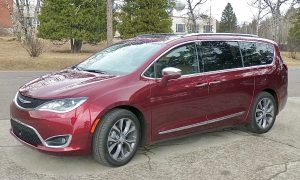
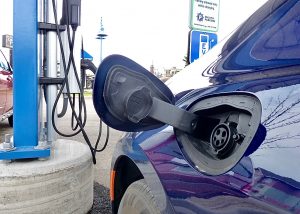
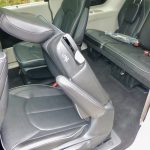
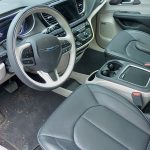
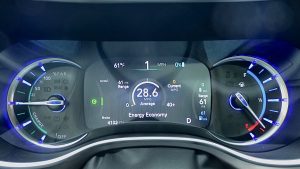
 John Gilbert is a lifetime Minnesotan and career journalist, specializing in cars and sports during and since spending 30 years at the Minneapolis Tribune, now the Star Tribune. More recently, he has continued translating the high-tech world of autos and sharing his passionate insights as a freelance writer/photographer/broadcaster. A member of the prestigious North American Car and Truck of the Year jury since 1993. John can be heard Monday-Friday from 9-11am on 610 KDAL(www.kdal610.com) on the "John Gilbert Show," and writes a column in the Duluth Reader.
John Gilbert is a lifetime Minnesotan and career journalist, specializing in cars and sports during and since spending 30 years at the Minneapolis Tribune, now the Star Tribune. More recently, he has continued translating the high-tech world of autos and sharing his passionate insights as a freelance writer/photographer/broadcaster. A member of the prestigious North American Car and Truck of the Year jury since 1993. John can be heard Monday-Friday from 9-11am on 610 KDAL(www.kdal610.com) on the "John Gilbert Show," and writes a column in the Duluth Reader.